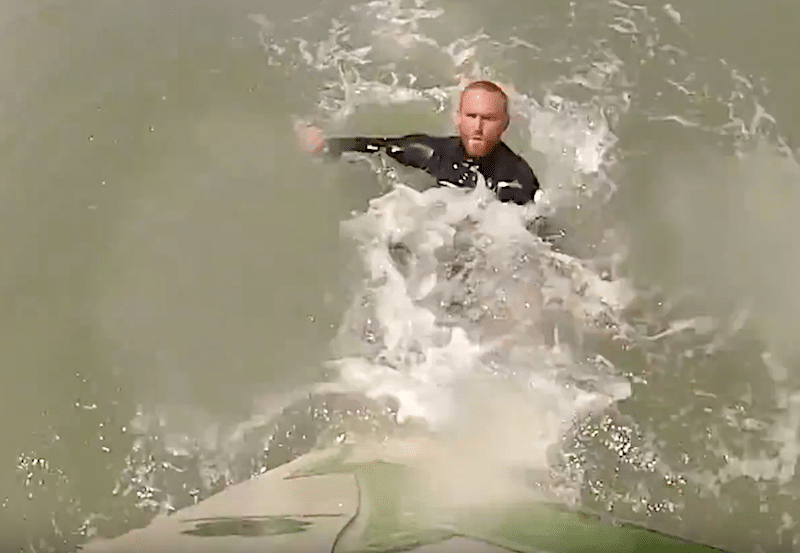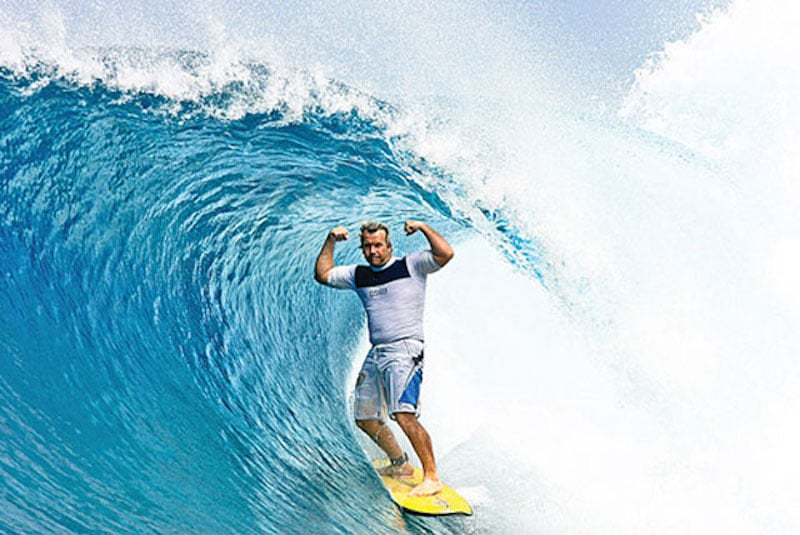Noted anti-Asian surfboards warrior goes after Firewire CEO Mark Price…
Some years ago now, I wrote a long-form story on the former world champion surfer Martin Potter. In the course of researching the story, which took six months, I spoke to the South African pro surfer turned Gotcha’s VP of marketing, Mark Price, who is now the CEO of Firewire surfboards.
Price spoke kindly of Martin despite accusations that he was “jealous” of Martin’s success.
“There are a lot of pro surfers out there that kids wanna surf like. But there are very few pro surfers that kids want to be like. And, if you’ve got one of those guys, they’re worth their weight in gold. And that’s the fact of the matter. Pottz was worth his weight in gold,” said Mark.
I liked him. A calm, rational sorta cat. Always quick to return calls. Open. Honest enough.
A few days ago, in response to an Instagram campaign by the eighties shaper Peter Schroff against Firewire’s offshore manufacturing, and Price personally, I called again.
How did he feel about posts like this?
And this?
This?
Of course, I’d lost Mark’s telephone number long ago.
But then Schroff posted Mark’s email address and his personal telephone number.
Hello!
When Mark called me back, as he’s quick to do, he said he wasn’t interested in becoming embroiled in a blood feud, which I naturally would’ve preferred, but sent me the link to an interview he’d recently done with The Business of Surf’s Brad Bricknell.
It’s an interview heavy on the buttered gravy (Sample quote: “In the last 12 years though, Mark Price has led a surfboard revolution… pioneered the space and indelibly changed the landscape… and not just in business, but for the good of the environment too.“), ooowee, dripping chins hither and yon etc.
But it covers, and covers well, the most contentious of Schoff and whomever else’s charges.
BRAD: It’s commonly known that manufacturing and selling surfboards is a low margin game. Do you ever see that changing at any point in the future? There are really only 2 levers to pull – either cost or RRP?
MARK: In the time we have been in business, we’ve seen the RRP go up. However, I think this is part of a much larger conversation around the overall surfboard marketplace and business model, which is pretty broken.
I think that there are 2 main factors that are driving down retail margins for surfboards (and wholesale margins), basically margins across the entire supply chain. One is probably the fact that it’s the only product category in the world where a very high percentage of surfboards (perhaps as high as 25%?) are sold outside of retail – factory direct, at prices that are below our wholesale prices. So that’s one challenge.
The other one is that it’s probably the only sporting good product in the world where there are 500-plus manufacturers of varying scale all competing for a piece of the pie. Therefore, you don’t get the economies of scale you usually get in other industries where the market leaders have a fairly large share of the total market.
On a related note, Firewire has copped a lot of flak over the years for building boards in Asia and this whole Asian sweatshop stereotype that’s out there. Two things on that:
Our factory is ISO9000 Certified, which is a quality control certification around factory processes and consistent outcomes, and within the next 12 months, we will be Fair Trade certified as well, which is a labor standard that no other surfboard factory, and not many other factories period, could meet.
Nor would they be willing to make the investments in qualitative labor practices in order to qualify for FT certification. Fortunately for us we already had the bulk of those benchmarks in place, so we were already almost there.
With that in mind, we are running the furthest thing from a sweatshop. But the bigger question is why did we go offshore? Some on Social Media like to claim that it’s because we’re greedy assholes who just want to get rich. (laughs). I’m sure you’ve heard the old joke, ‘How do you make a small fortune in the surfboard industry? Start with a large one!’
If you recall when we started in 2006, we set up factories in Burleigh Heads and San Diego and spent a small fortune to get those up and running.
But because of the complicated nature of our boards and the materials cost, we had to put them out there at a significantly higher price point than our competitors, and they didn’t sell.
And the reason for that is for decades, the domestic board builders have built disposable product. They have trained the consumer that your board is going to ride great, but after a year it’s probably worth next to nothing! Garage sale maybe, for a couple of hundred bucks. It’s yellow, time to get a new one and the deck looks like a golf ball. So, we were forced to drop our prices to the same level as the other premium PU board builders until consumers could appreciate what we were building which took time, and when we did that, the company took off like a rocket ship. However, our domestic manufacturing margins became so low that we could not support the business.
So rather than pillory us for going offshore I think they should look themselves in the mirror and acknowledge that they created a price to value equation in the consumer’s mind that was too low!
Over decades, they trained the consumer that that’s all a surfboard was worth. Because if you talk to board builders they will always tell you that surfboards are too cheap based on what it takes to build them. Which is true, but the consumer only cares about the value to them, they don’t care what it costs to make.
BRAD: And once you have precedence in the market, it’s difficult to change it….
MARK: Exactly. And what’s so ironic is now that we have entered the market and succeeded around technology, and we were forced to go offshore (and lost a small fortune) our competitors who are now trying to compete against us with technology are going offshore to manufacture as well, because they’ve hit the same wall that we did! And some of them are doing it in a bit of disingenuous manner – without fully disclosing the country of origin or acknowledging it in the subtlest way possible. Whereas we have laminated a decal on the rail since day one with that information.
I don’t mind getting sh*t for building our boards offshore because that is factually accurate, but I won’t accept the premise that we went there just to make a buck. We went offshore to stay in business!
We run a high-quality operation and we were forced offshore by the (broader) business model. And we’ve been instrumental in helping raise the price of surfboards at retail over the last 10 years as consumers realized that we offered increased durability without sacrificing performance (a higher price to value equation to come back to an earlier point), and that has benefitted all board builders.
BRAD: Part of your business model is also to hold a lot of stock – are there pros and cons to that strategy?
MARK: Yeah there are, but surfing is such a highly individualized activity, as you know. If you are a snowboard brand you could probably offer less than 20 SKU’s and cover a pretty high percentage of potential customers, whereas with surfing you wouldn’t even get out the gate! Remember when it comes to surfboards, the term SKU drills down to the individual model, length/dims and fin system. So, it’s a business necessity if you want to cater to a variety of surfing abilities, physical conditioning, and wave conditions.
On the plus side, unlike the apparel industry that is highly seasonal; a surfboard that didn’t sell in March, is still viable in July! I’ll take the trade-off of a lot of SKU’s relative to our revenue, but a fairly simple business model from a seasonal standpoint. That said, we have fairly sophisticated tools in place to rationalize every SKU so our inventory mix is kept tight.
BRAD: What does someone like the greatest surfer of all time bring to the business?
MARK: (Laughs) Nothing! (More laughs) Kelly’s involvement in the company was substantial for a number of reasons. Obviously, we were able to launch Slater Designs, his namesake brand, and if ever there was a product category that was perfectly aligned with an athlete, it would be surfboards and Kelly! So, it was a great entrée into the market for that brand and its had an impact already.
But I think of equal importance – when Kelly left a PU company and joined a company like Firewire that was exclusively EPS and epoxy, it caused a large segment of the surfing population to re-look at those materials.
When we first started we probably had the attention and interest of 20% of the market, maybe. With Kelly’s involvement, not only did we launch his brand, but now 75% plus percent of potential customers are now looking at the whole range of products we made.
The proof was that we initially thought that Slater Design’s would cannibalize some of the Tomo and Firewire business, but it didn’t. They all grew for that reason.
Etc.
Read the rest here. And do feel free to respond.







